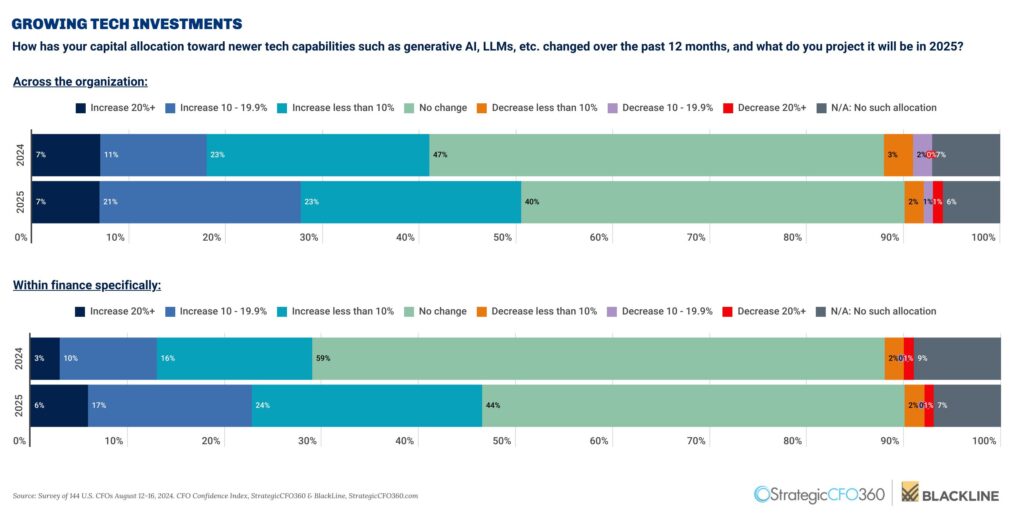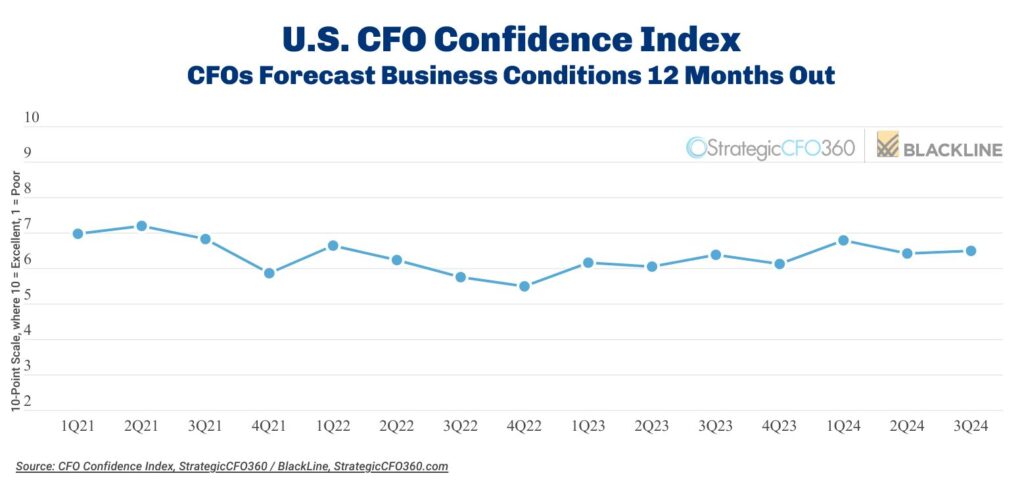Like many technology company CFOs, Karen Walker’s remit as a strategic partner to the CEO and corporate functions demands close attention to the present value of internal technologies and whether they still stand up in an era of constant breakthroughs. “With some of the newer technologies like generative AI, I have to be looking forward to what’s coming,” says Walker, CFO of Sysdig, a privately held provider of real-time cloud security.

Finance chief Bob Feller also has his eye on new technology products. Still, he’s more concerned with reducing the number of tools used internally at Auvik Networks, a cloud-based IT management company with 300 employees in 5 countries. “When I became CFO a year and a half ago, we had over 250 tools here. Employees want the coolest technology, but they often don’t think about how the applications integrate [into] a source of truth,” Feller says. Entrusted to think deeply about IT applications and management internally and the market relevance of their companies’ technologies and services, finance chiefs like Feller and Walker are constantly thinking about the finance and enterprise tech stacks.
To find out how tech-savvy CFOs choose and deploy technology to their organizations’ advantage, StrategicCFO360 asked (or prompted, if you will) eight of them about stewardship of the IT budget, the products that have captured their interest and the tightrope walk of prioritizing tech investments across an entire organization. Following are some of the highlights.
(Their comments have been edited for concision and comprehension.)
How would you describe the overall state of technology spending?
“The macro environment has heightened scrutiny around technology spend, creating a big difference between `must have’ and `nice to have’ applications. This often favors larger vendors that provide mission-critical services or smaller vendors that provide a demonstrable ROI. Niche vendors in the `nice to have’ category tend to be at risk. Our recent technology decisions echo this theme.”
—David Jolley, CFO of Domo, a publicly traded business intelligence and management platform

A Guide to Surviving AI
To harness the power of AI, finance chiefs need to sharpen their skills in five areas.
How do you see your role as the steward of business application management and spending?
“My goal is to get information in the hands of people that need it now. The company has the information; the data is there; it’s just that we don’t know where to find it. The opposite of that is when you get an email or send one and need to find it afterward; you just stick the person’s name in the search box, and it pops up. But if I’m trying to find a quote in an email I received from a CFO seven years ago, and I forgot the name of the person, I need help. … It’s something we’re trying to figure out to deliver value to our internal and external stakeholders. Maybe the answer is generative AI in some way.”
—Ken Stillwell, CFO of publicly traded Pega, a workflow automation and AI-decisioning platform
“It’s my job to evaluate ways to improve the efficiency and speed of financial reporting and forecasting cycles, liberating the teams from routine transactional tasks to partner strategically with the rest of the business.”
—Karen Walker, Sysdig
Tell us about some of the technologies you’ve recently deployed to increase efficiency in the accounting and finance or other functions.

“We have areas of focus in our tech spend—organization, efficiency and enablement. To that end, we’re using one of our own technologies, Process Fabric, an employee productivity tool that looks across hundreds of independent business applications to provide rapid cross-app visibility. We’re giving employees a single portal that can interact with multiple apps, presenting a way to more efficiently organize and complete their work tasks.”
—Ken Stillwell, Pega
“Inside finance, we’re using technology from BlackLine, Workiva and Alteryx to eliminate, optimize and reduce workloads. The tools help reduce errors, perform reconciliations and learn while they go. We just started using BlackLine for automation, which is well-tested for data accuracy and eliminating repetition. We’re also using AuditBoard, a platform that helps us manage audit risk and compliance. It links our accountants to the external auditor to run more efficient and cost-effective audits. The tool keeps track of what has been resolved or remains open. Lastly, we’re using GitHub’s Copilot and ChatGPT for writing software code and content creation.”
—Paul Rouse, CFO of publicly traded Thryv Holdings, a provider of marketing and customer communications software to small businesses
“We just started using Spiff, incentive compensation management software that Salesforce acquired (in February 2024). The tool improves the efficiency of our commission structure. Another new tool we invested in is ObserveAI, an AI-powered automation and conversation intelligence tool that listens in on customer calls to answer their questions more effectively. And we recently implemented HubSpot as our CRM system to generate leads, which is then integrated into our Salesforce CRM to provide the leads to salespeople.”
—Ken Talanian, CFO of Skillable, a virtual learning technology company
Which brand new technologies have captured your interest as a possible future investment?
“We’re a big Microsoft 365 shop and are experimenting with Copilot. We have about 100 people using Copilot [in] everything from Microsoft Outlook to Word to Teams. I’m personally using it to record and transcribe conversations like the one we’re having, as it will recap the major points and action items. I also use it in my weekly meetings to ensure the action items are circulated to the right people, helping us stay aligned.”
—Jim Caci, CFO of publicly traded AvePoint, a vendor of SaaS solutions for Microsoft 365 users

“There is one sub-sector in technology getting budget approval, and that is AI. Is there anyone not talking about AI? Companies are spending money to get `AI-ready,’ which means getting data consolidated, cleansed and formatted to take advantage of it when the right applications are developed. The use cases are still nascent, and the AI solutions for finance that I’ve been pitched so far haven’t been very compelling; there hasn’t been a solid, demonstrable ROI. However, it feels like we are still in the very early stages of developing strong AI use cases.”
—David Jolley, Domo
“We’re in the process of moving away from our homegrown platform and beginning to use third-party solutions through Salesforce. One of the areas we’re looking at as we scale the business over the next five years is our quote-to-cash engine and lifecycle. To do that, we need to build a more seamless user experience, bringing workflows up to speed to enable better billing on the cash application side, matching incoming payments to outstanding invoices and proper accounts.”
—Adam Ante, CFO of publicly traded Paycor, a human capital management platform

Like every CFO, I’m thinking about how to use AI to improve efficiency. I like opportunities for a lab-based approach to learning your own data. A case in point is `prompt engineering,’ the design of inputs for AI tools. In a perfect world, I’d be able to ask the tool what our revenue will look like in Europe this quarter and have that analysis in a second, versus asking the head of FP&A and waiting an hour or two.”
—Ken Talanian, Skillable
How do you balance the business’s competing priorities for new technologies, given that every function, department and business unit wants the `shiny new thing,’ and budgets are finite?
“It’s the hardest thing. Everybody needs more and wants more. I’m a superfan of technology, but I take a pragmatic approach since, for some things, I don’t need to be on the bleeding edge. Depending on the tool, I ask if it’s a strategic imperative, supports a top-line initiative or will make us more productive from a marketing perspective. Will it clear a bottleneck or solve a key internal operational challenge? Following the discussion, I ask if the investment could wait a quarter or a year? If the answer is yes, then we probably should do that.”

—Adam Ante, Paycor
“My decision comes down to whether the investment is mission critical and has a clear, demonstrable ROI. If so, it’s much easier to find a way to pay for the technology. If it’s not mission critical and the ROI is speculative, we, like most companies, are either eliminating or reducing the tech spend.”
—David Jolley, Domo
“Having done this a bunch of times, I’ve [become] pretty ruthless. Every software vendor is talking up AI, for example. But the only companies making money on AI are the hardware makers like Nvidia. Software companies, on the other hand, are losing money because CFOs don’t want to spend money until we know what we’re getting. `Show me a very clear ROI,’ I say.”
—Bob Feller, Auvik Networks








